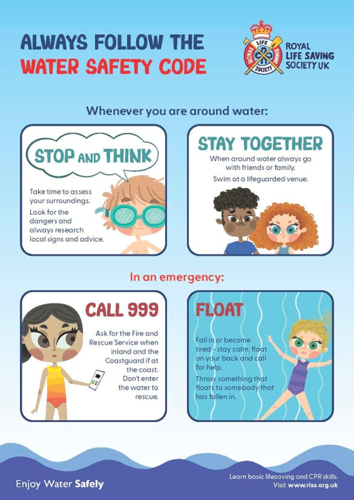Health and safety around the river
There are many recreational activities that take place on and around the river, such as swimming, rowing and kayaking. With the river being part of the natural environment, it presents certain risks to the health and safety of users which can be reduced by bearing in mind the information and advice provided below.
Health
Exposure to river water can increase the risk of gastrointestinal illnesses, or stomach bugs, which may cause diarrhoea and/or vomiting, as well as respiratory, skin, ear and eye infections. Most symptoms of these illnesses caused by micro-organisms such as norovirus, giardia and cryptosporidium, will generally be relatively mild. However, there is also a risk of more severe infections caused by micro-organisms such as E. coli O157, which may cause severe gastrointestinal illness and leptospirosis (Weil’s disease), which can cause liver and kidney problems.
There is a designated bathing site at the River Severn in Ironbridge. The bathing water is located around 450m upstream of the Ironbridge, entry is by the “beach” behind the Museum of the Gorge and the Ironbridge Tourist Information Centre.
Please note: the bathing water has been designated as ‘poor’ due to microbiological samples taken during the 2024 bathing season exceeding safe levels of bacteria. As a result, advice against bathing has been issued, and a warning sign is displayed at the bathing site. If Telford & Wrekin Council is notified of a potential pollution incident, the warning sign will be updated and further details will be available on the Environment agency website using the link below. Sampling has now commenced for the 2025 bathing season and the results can be found using the link below.
Live information displaying the annual bathing water designation, advice around bathing and the date of the last water sample:
Visit the Environment Agency's website:
- for general advice on bathing water quality
- download information from the Environment Agency about foam in rivers and still waters
Tips for staying healthy when using the river:
- before swimming, check the sampling results for the river, check the noticeboard and observe river condition and consider not entering the water if anything about the conditions gives you cause for concern – pay particular attention after heavy rain
- cover any cuts or abrasions with waterproof plasters
- try not to swim in contact lenses, but if you do, daily disposables are best – ensure you wash your hands before taking them out
- wear suitable footwear to avoid cutting your feet when entering the water
- do your best to avoid swallowing the water
- re-consider if you feel your immune system might be compromised, for example by illness
- if in boats, use water bottles with caps that help prevent the nozzle from becoming contaminated with river water from splashing
- wash your hands thoroughly with soap and running water before eating or handling food
- wash and dry equipment such as wetsuits, oars, swimming goggles etc. carefully after use, and wash your hands afterwards
- hand sanitiser is better than nothing if you don’t have access to running water for hand-washing, but don’t rely on it alone if you can help it
- if you do become unwell with diarrhoea or any other symptoms, seek medical help and let them know you have been exposed to river water. Visit the NHS website for advice on looking after yourself and preventing others from being ill.
- follow any sport-specific advice issued by any governing bodies your sport/activity may be affiliated to
Safety
The river can be dangerous, especially for children. Particularly in hot weather, children may look to go swimming in open water to cool down and have fun. Although people may swim well in the controlled environment of a warm indoor pool, that does not always mean they will be able to swim well in a natural environment in cold water outdoors. This environment comes with various risks:
- cold water shock
- hidden currents
- steep, slippery banks
- hidden underwater dangers
- unknown depth.
Educating children on these dangers is important in preventing these tragic incidents.
The Royal Life Saving Society and the Canal & River Trust have some good resources with more information on this to discuss with your children:
There is also the simple and easy-to-remember steps in the Royal Life Saving Society’s Water Safety Code, to follow both before entering the water and in the event of an incident, to help to keep you and others safe.
- stop and think: take time to assess your surroundings. Look for the dangers and always research local signs and advice.
- stay together: when around water always go with friends or family. Swim at a lifeguarded venue.
- call 999: ask for the Fire and Rescue Service when inland and the coastguard if at the coast. Don't enter the water to rescue.
- float: if you fall in or become tired, stay clam, float on your back and call for help. Throw something that floats to somebody that has fallen in.

Last updated : 30 May 2025
